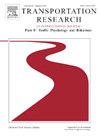Driver dysfunctional impulsivity dominates over others in anger expression
IF 4.4
2区 工程技术
Q1 PSYCHOLOGY, APPLIED
Transportation Research Part F-Traffic Psychology and Behaviour
Pub Date : 2025-07-08
DOI:10.1016/j.trf.2025.06.026
引用次数: 0
Abstract
The aim of this study is to examine whether driver impulsivity predicts aggressive driver behavior and to compare the predictive power of driver impulsivity and general impulsivity towards aggressive driver behavior. A total of 312 drivers, 113 women and 199 men, participated in the study and completed the Demographic Information Form, Driver Anger Expression Inventory, Barrat Impulsivity Scale-Short Form and Impulsive Driver Scale by way of an online link. The hierarchical regression analyses showed that driver dysfunctional impulsivity positively predicted physical anger expression, verbal anger expression and the use of a vehicle to express anger whereas it negatively predicted the adaptive anger expression. Driver functional impulsivity positively predicted physical anger expression, the use of a vehicle to express anger and the adaptive anger expression. The dominance analyses results show that driver dysfunctional impulsivity completely dominates all other driver impulsivity and general impulsivity dimensions for both adaptive and non-adaptive anger expression of drivers. The results of the study emphasize the importance of conceptually addressing impulsivity in future studies and the impact of the measurement tool to be used on the results.
司机功能失调冲动在愤怒表达中占主导地位
本研究的目的是检验驾驶员冲动是否能预测攻击性驾驶行为,并比较驾驶员冲动和一般冲动对攻击性驾驶行为的预测能力。共有312名司机,其中113名女性和199名男性参与了研究,并通过在线链接的方式完成了人口统计信息表、司机愤怒表达量表、Barrat冲动量表简表和冲动司机量表。层次回归分析表明,驾驶员功能障碍冲动性对肢体愤怒表达、言语愤怒表达和使用交通工具表达愤怒有正向预测作用,对适应性愤怒表达有负向预测作用。驾驶员功能性冲动正向预测躯体性愤怒表达、使用交通工具表达愤怒和适应性愤怒表达。优势度分析结果表明,驾驶员功能失调性冲动在驾驶员的适应性和非适应性愤怒表达中都完全支配着其他驾驶员冲动和一般冲动维度。研究结果强调了在未来的研究中从概念上解决冲动性的重要性,以及测量工具对结果的影响。
本文章由计算机程序翻译,如有差异,请以英文原文为准。
求助全文
约1分钟内获得全文
求助全文
来源期刊
CiteScore
7.60
自引率
14.60%
发文量
239
审稿时长
71 days
期刊介绍:
Transportation Research Part F: Traffic Psychology and Behaviour focuses on the behavioural and psychological aspects of traffic and transport. The aim of the journal is to enhance theory development, improve the quality of empirical studies and to stimulate the application of research findings in practice. TRF provides a focus and a means of communication for the considerable amount of research activities that are now being carried out in this field. The journal provides a forum for transportation researchers, psychologists, ergonomists, engineers and policy-makers with an interest in traffic and transport psychology.

 求助内容:
求助内容: 应助结果提醒方式:
应助结果提醒方式:


